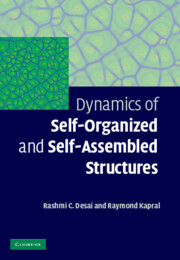Book contents
- Frontmatter
- Contents
- preface
- 1 Self-organized and self-assembled structures
- 2 Order parameter, free energy, and phase transitions
- 3 Free energy functional
- 4 Phase separation kinetics
- 5 Langevin model for nonconserved order parameter systems
- 6 Langevin model for conserved order parameter systems
- 7 Interface dynamics at late times
- 8 Domain growth and structure factor for model B
- 9 Order parameter correlation function
- 10 Vector order parameter and topological defects
- 11 Liquid crystals
- 12 Lifshitz–Slyozov–Wagner theory
- 13 Systems with long-range repulsive interactions
- 14 Kinetics of systems with competing interactions
- 15 Competing interactions and defect dynamics
- 16 Diffusively rough interfaces
- 17 Morphological instability in solid films
- 18 Propagating chemical fronts
- 19 Transverse front instabilities
- 20 Cubic autocatalytic fronts
- 21 Competing interactions and front repulsion
- 22 Labyrinthine patterns in chemical systems
- 23 Turing patterns
- 24 Excitable media
- 25 Oscillatory media and complex Ginzburg–Landau equation
- 26 Spiral waves and defect turbulence
- 27 Complex oscillatory and chaotic media
- 28 Resonantly forced oscillatory media
- 29 Nonequilibrium patterns in laser-induced melting
- 30 Reaction dynamics and phase segregation
- 31 Active materials
- References
- Index
preface
Published online by Cambridge University Press: 10 February 2010
- Frontmatter
- Contents
- preface
- 1 Self-organized and self-assembled structures
- 2 Order parameter, free energy, and phase transitions
- 3 Free energy functional
- 4 Phase separation kinetics
- 5 Langevin model for nonconserved order parameter systems
- 6 Langevin model for conserved order parameter systems
- 7 Interface dynamics at late times
- 8 Domain growth and structure factor for model B
- 9 Order parameter correlation function
- 10 Vector order parameter and topological defects
- 11 Liquid crystals
- 12 Lifshitz–Slyozov–Wagner theory
- 13 Systems with long-range repulsive interactions
- 14 Kinetics of systems with competing interactions
- 15 Competing interactions and defect dynamics
- 16 Diffusively rough interfaces
- 17 Morphological instability in solid films
- 18 Propagating chemical fronts
- 19 Transverse front instabilities
- 20 Cubic autocatalytic fronts
- 21 Competing interactions and front repulsion
- 22 Labyrinthine patterns in chemical systems
- 23 Turing patterns
- 24 Excitable media
- 25 Oscillatory media and complex Ginzburg–Landau equation
- 26 Spiral waves and defect turbulence
- 27 Complex oscillatory and chaotic media
- 28 Resonantly forced oscillatory media
- 29 Nonequilibrium patterns in laser-induced melting
- 30 Reaction dynamics and phase segregation
- 31 Active materials
- References
- Index
Summary
The idea for this book arose from the observation that similar-looking patterns occur in widely different systems under a variety of conditions. In many cases the patterns are familiar and have been studied for many years. This is true for phase-segregating mixtures where domains of two phases form and coarsen in time. A large spectrum of liquid crystal phases is known to arise from the organization of rod-like molecules to form spatial patterns. The self-assembly of molecular groups into complex structures is the basis for many of the developments in nanomaterial technology. If systems are studied in far-from-equilibrium conditions, in addition to spatial structures that are similar to those in equilibrium systems, new structures with distinctive properties are seen. Since systems driven out of equilibrium by flows of matter or energy are commonly encountered in nature, the study of these systems takes on added importance. Many biological systems fall into this far-from-equilibrium category.
In an attempt to understand physical phenomena or design materials with new properties, researchers often combine elements from the descriptions of equilibrium and nonequilibrium systems. Typically, pattern formation in equilibrium systems is studied through evolution equations that involve a free energy functional. In far-from-equilibrium conditions such a description is often not possible. However, amplitude equations for the time evolution of the slow modes of the system play the role that free-energy-based equations take in equilibrium systems. Many systems can be modeled by utilizing both equilibrium and nonequilibrium concepts.
Currently, a wide variety of methods is being used to analyze self-organization and self-assembly. In particular, microscopic and mesoscopic approaches are being developed to study complex self-assembly in considerable detail.
Information
- Type
- Chapter
- Information
- Dynamics of Self-Organized and Self-Assembled Structures , pp. xiii - xivPublisher: Cambridge University PressPrint publication year: 2009
